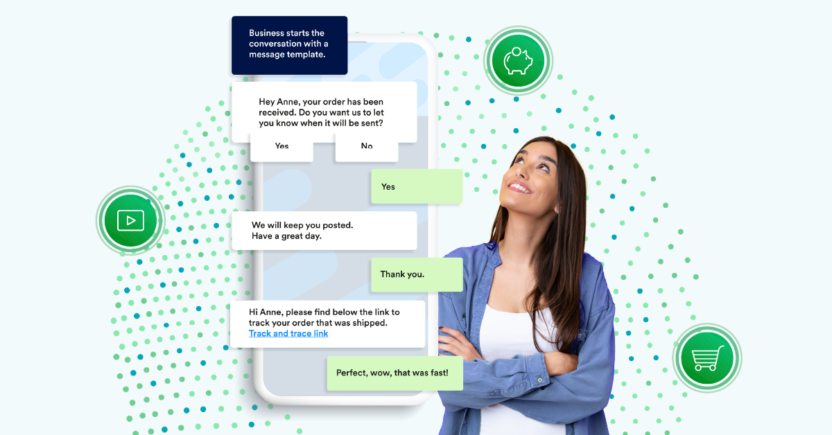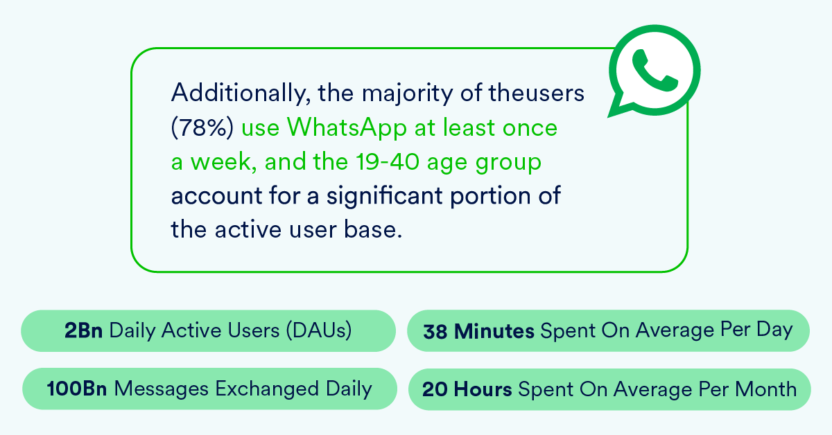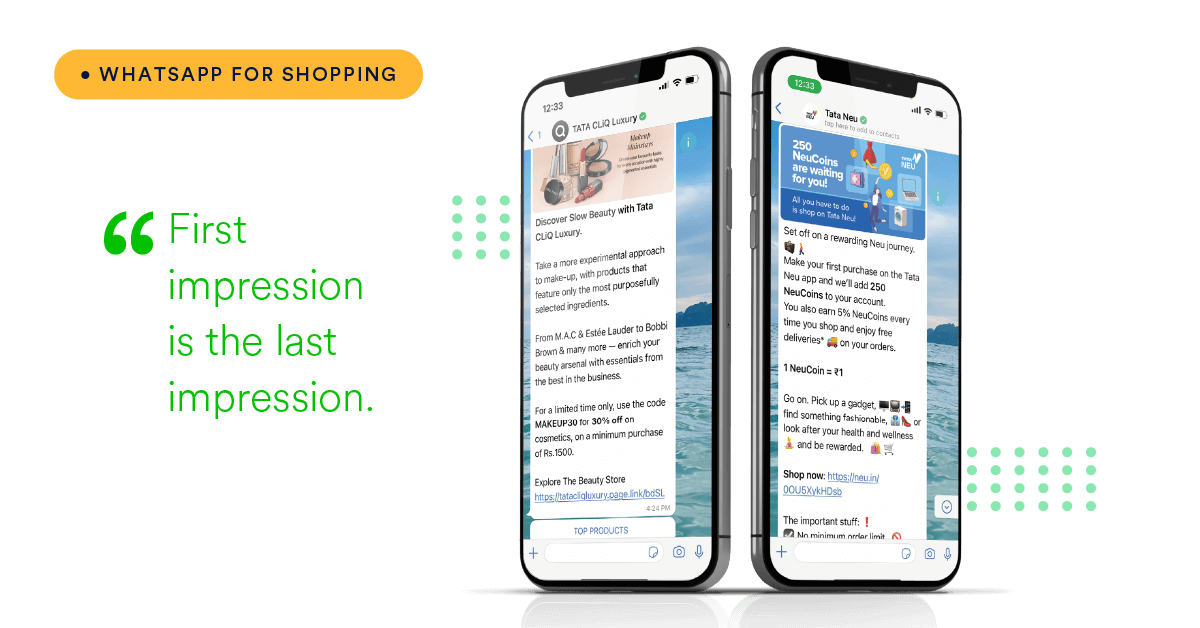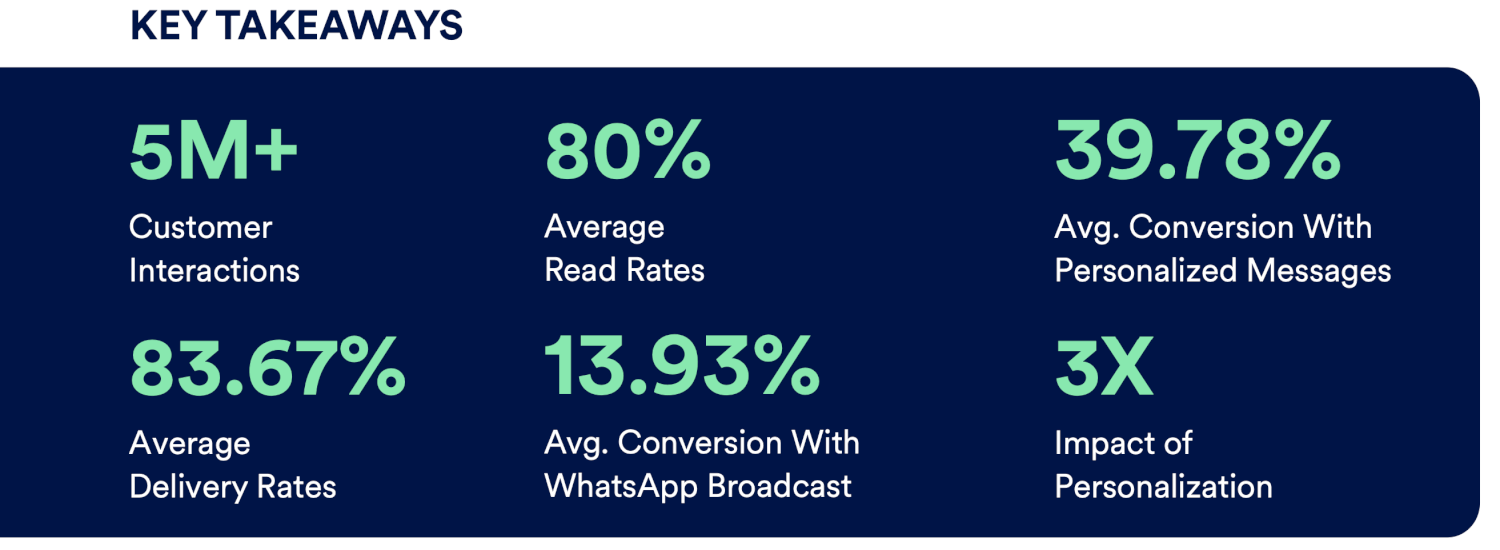Using WhatsApp Marketing for Conversational Commerce
The Future of Conversational Commerce: Why WhatsApp Is a Must-have for a Great Customer Engagement Plan

Marketing efforts have evolved through the years, and so should your engagement plan. The benefits of using WhatsApp Business marketing include not only improving your customer experience but also making your marketing campaigns stand out with a personal touch.
What Is Conversational Commerce?
The term “Conversational Commerce” or “C-Commerce” was coined in 2015 by Uber’s Chris Messina. Any consumer business that uses a conversational platform/messaging apps to speak to its customers directly is categorized as “C-Commerce”.

An interactional exchange between a customer and a business has many advantages. Customers can enter into this exchange at any point of their buyer’s journey, from the discovery/awareness stage to the consideration/purchase stage. It can also reduce customer wait times by eliminating the need for telephonic support in a buyer’s journey.
And what does that mean for business?
Imagine a customer calling your company only to have to wait five minutes and having to dial a bunch of keys before they drop from the journey altogether!
More importantly, this interactional exchange gives a business the power to remain engaged with its customers, without losing out on a customer’s most valuable currency: attention. In a world where options are numerous and demands are soaring losing customers due to unexplored marketing communication strategies should never happen.
Why As a Brand Should You Use WhatsApp for Your Business?
With more than 2 billion users, this app, first released in 2009, is the world’s most popular downloaded messaging platform. Brands across the world are slowly delivering business communication through this platform, which has some remarkable metrics and growth rates. And with WhatsApp’s end-to-end encryption, it does not have any security risks that some other channels might.

And it is not just organizations! According to Meta’s “Business Messaging Research Study, September 2020”, around 70% of the respondents mentioned that they were more likely to do business with an organization that could connect with them via a messaging app than one that could not. It is imperative that businesses use this platform because the number of WhatsApp users who prefer brands with this capability will only be on the rise.
How Can a Business Effectively Use Conversational Marketing/WhatsApp Marketing?
As WhatsApp adoption is on the rise, how can your organization use WhatsApp as a successful channel to engage and reacquire more customers? How do some organizations use WhatsApp to attract more customers to their platform and disseminate their offers and deals?
Let’s take a look, vertical-wise:
WhatsApp for
• Reach/engage with your customers through proper segmentation.
• Connect through relevant direct messaging to your segmented audience to reduce churn and improve customer experience.
• Build your brand! Ensure your messages have personalized CTAs and deep links.
• Send your customers information about seasonal sales and save them the hassle of a complicated search.
• Learn and accept what works with your customers but more importantly, what doesn’t!

What Are the Advantages of WhatsApp Marketing?
It is not just about adopting a new channel to increase customer engagement or to add more options to your marketing strategies. WhatsApp is the future when it comes to accelerating your sales outcomes as well. It has been estimated that Europe alone will spend 160 billion on digital ads by 2027. And IM will be part of the next wave of innovative channels. You are mostly part of this wave right now!

WhatsApp is evolving and so should your marketing and engagement strategies. With an IM like WhatsApp, there are a lot more possibilities than just informing your customers through WhatsApp Chats about great new deals and offers, including:
- Redirecting them to a landing page after a failed/incomplete purchase
- Sharing a product catalog to inform customers about your latest products
- Automating customer support and doing away with lengthy customer calls
- Automated messages of regular updates like bank transactions, product catalogs
- Don’t just “receive” inputs. Take feedback from your customers. Remember that communication is key!
IM platforms have come a long way since the early days of character-limited messages. With WhatsApp dominating the messaging apps section across geographies and demographics, customers are careful about where to invest their most valuable currency: time. This is why a marketing campaign is a must-have for all your strategies. Customers do not like giving their precious time to organizations that make the engagement journey cumbersome and full of stopgaps, instead of a streamlined, easy process.

Frequently Asked Questions (FAQ)
How to Use WhatsApp for Marketing?
Firstly, you would need access to a Business WhatsApp account. Don’t look at it like the tools at your disposal to help you accomplish your goals but as a viable channel. And remember, it depends on your end goal but marketing through WhatsApp has a lot of benefits and can be done in a wide range of ways including segment targeting, product announcement, offering new deals, and customer support, among others. You can also share important customer-specific updates or news as well for all your marketing needs.
How to use WhatsApp Marketing Campaign effectively?
Ensure you always communicate your messages through a verified business profile to your users to avoid security risks. This way, you will also help valuable customers protect their data. Send all your important information to users, and ensure you share solutions and not spam!
What verticals are covered in this E-Book?
Access to this free E-Book covers useful insights and data for Shopping/Commerce, Banking and Finance, and Entertainment. Not only will it help you understand how to deliver your services to your customers but also help you with the right kind of custom communication/messaging pillar you need to create your own brand niche.
How to use WhatsApp for promotion?
WhatsApp presents you with even more opportunities than most channels since most customers use WhatsApp on a daily basis. You can leverage the data you collect to help your new customers (and old) find services that can be easily found: through messages or through chatbots/automated customer support.
What are some of the disadvantages of using WhatsApp for business communication?
There is no disadvantage while availing this service! That’s the best part. To find out more, click here.
What are some examples/use-cases of using WhatsApp for Shopping?
You can use WhatsApp for recommending first purchases. First purchases are always exciting, and ensuring that your customers go for them is important. Not only does this help you understand your customers better but it also gives you permission or access to the next stages of a purchase.
What are some examples/use-cases of using WhatsApp for Banking?
You can use WhatsApp’s service for onboarding new customers. Ensure that whatever products you offer are accompanied by some contextual information. Since WhatsApp is an IM, as a business, you can send personalized messages to truly make your customers feel welcome.
What are some examples/use-cases of using WhatsApp for Entertainment?
One of the benefits for businesses is that they can WhatsApp’s service for reactivating their dormant users. With WhatsApp as a channel, you can send customers relevant service they might like from time to time (it is important to space out your recommendations and your communication to dormant users), offer them amazing deals on re-purchases, and also help them to go straight to the landing page.
As a business, should you look to adopt WhatsApp?
Using WhatsApp for business, as a marketer, if you are looking to increase the adoption of their products/platforms this integration is for you. Additionally, if you want to grow your revenue (due to stagnant customer growth issues) you should definitely explore this easy yet engaging. Communicating your customer’s needs will provide you with the perfect opportunity to connect with them deeper.
How to use whatsapp for business promotion?
Depending on your country and target audience, you can think creatively on how to use your campaigns. To get started, you can go ahead and use it as a quick customer service/informational chat service. To know more on how to effectively use it, read this.
What is a WhatsApp Business API?
WhatsApp Business API will help businesses to automate customer service with automated replies, ensure a smoother connected experience and help provide customers more information about your company. You can also combine with different WhatsApp marketing tools to enhance your
How to use WhatsApp Business for marketing?
Apart from using it as an automated customer service for promotional or transactional chat, you can also use it on other ways. You can also use it to personalize your messages.
